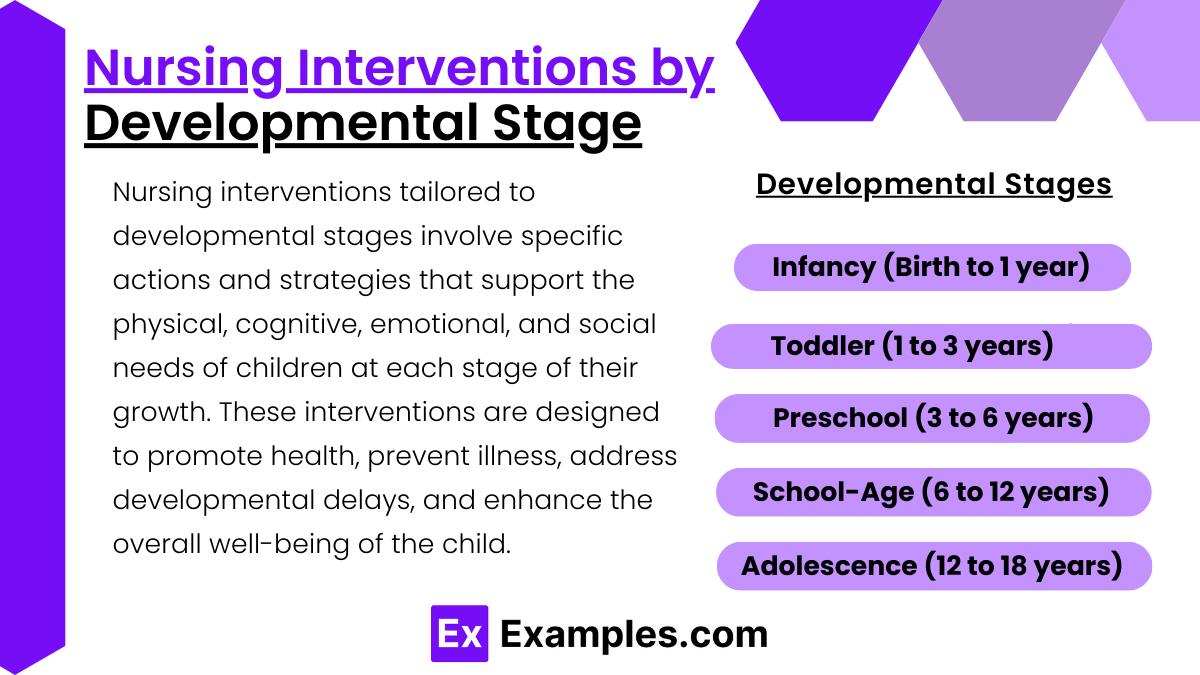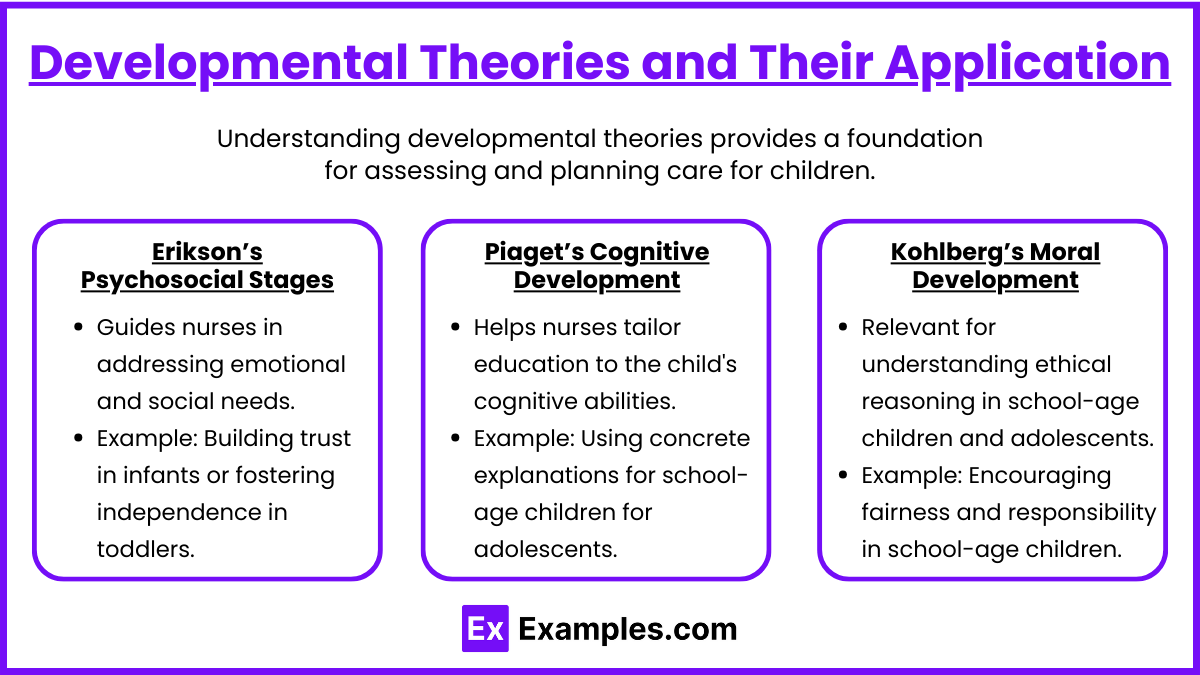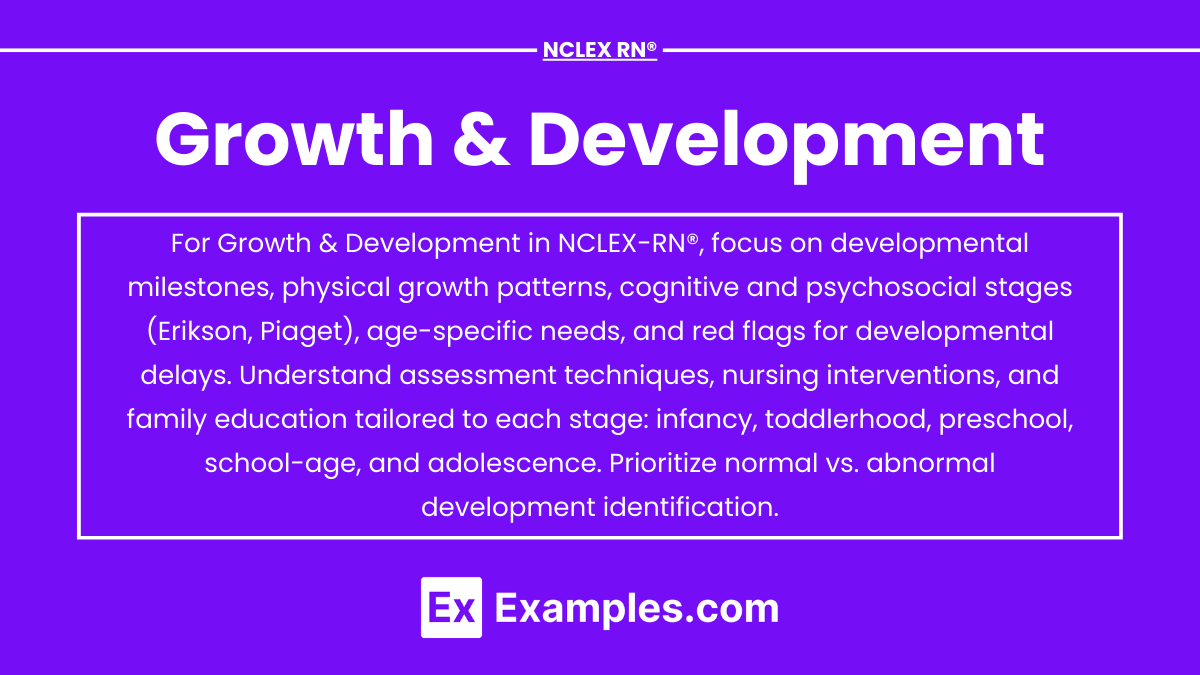Growth and development are fundamental aspects of pediatric nursing, encompassing physical, cognitive, emotional, and social progress from infancy to adolescence. For the NCLEX-RN® exam, understanding developmental milestones is crucial for assessing normal versus delayed development, planning age-appropriate interventions, and educating families. Key theories, such as those by Erikson and Piaget, provide a framework for evaluating psychosocial and cognitive development. Mastery of this topic ensures nurses can provide holistic care tailored to a child’s developmental stage, fostering optimal health and well-being.
Learning Objectives
In studying "Growth & Development" for the NCLEX-RN® exam, you should learn to identify and assess developmental milestones across physical, cognitive, emotional, and social domains for children from infancy through adolescence. Understand the principles of developmental theories, including Erikson’s psychosocial stages, Piaget’s cognitive development, and Kohlberg’s moral development. Evaluate normal versus delayed development and apply age-appropriate nursing interventions. Explore how growth and development concepts are used to provide holistic, family-centered care and promote child well-being. Apply your understanding to interpret developmental assessments, educate families, and implement nursing strategies in NCLEX-RN® practice scenarios.
Child health, growth, and development encompass physical, cognitive, emotional, and social progressions in children from infancy through adolescence. Understanding these milestones is crucial for assessing normal versus abnormal development, planning appropriate nursing interventions, and educating families.
Growth & Development Stages

Infancy (Birth to 1 year)
Physical Growth: Rapid growth; birth weight doubles by 6 months, triples by 1 year. Height increases by 50%. Fontanels close (posterior by 2-3 months, anterior by 12-18 months).
Gross Motor Skills:
2 months: Lifts head when prone.
4 months: Rolls from front to back.
6 months: Sits with support.
9 months: Pulls to stand, crawls.
12 months: Walks with assistance.
Fine Motor Skills:
2 months: Follows objects with eyes.
6 months: Transfers objects between hands.
12 months: Pincer grasp develops.
Cognitive Development (Piaget - Sensorimotor Stage):
Learns through sensory input and motor activity.
Object permanence develops by 8 months.
Psychosocial Development (Erikson - Trust vs. Mistrust):
Trust develops through consistent care and meeting needs.
Toddler (1 to 3 years)
Physical Growth: Growth slows. Pot-bellied appearance common.
Gross Motor Skills:
18 months: Walks independently, climbs stairs with support.
2 years: Runs, kicks ball.
3 years: Rides a tricycle, jumps.
Fine Motor Skills:
18 months: Scribbles.
2 years: Builds a tower of 6 blocks.
Cognitive Development (Piaget - Preoperational Stage):
Egocentric thinking. Symbolic play.
Psychosocial Development (Erikson - Autonomy vs. Shame and Doubt):
Developing independence. Common behavior includes "no" and temper tantrums.
Preschool (3 to 6 years)
Physical Growth: Growth remains steady; gains 4-6 lbs/year.
Gross Motor Skills: Skips, hops on one foot, throws and catches a ball.
Fine Motor Skills: Draws a person with multiple body parts, cuts with scissors.
Cognitive Development (Piaget - Preoperational Stage):
Imaginative play and magical thinking.
Psychosocial Development (Erikson - Initiative vs. Guilt):
Develops initiative through play and social interactions.
School-Age (6 to 12 years)
Physical Growth: Slow and steady. Gains 4-7 lbs/year. Permanent teeth begin to erupt.
Gross Motor Skills: Improved coordination and balance.
Cognitive Development (Piaget - Concrete Operational Stage):
Logical thinking begins; can understand cause and effect.
Psychosocial Development (Erikson - Industry vs. Inferiority):
Focuses on learning and achievement. Success fosters confidence.
Adolescence (12 to 18 years)
Physical Growth: Puberty begins. Growth spurts occur.
Cognitive Development (Piaget - Formal Operational Stage):
Abstract and hypothetical thinking.
Psychosocial Development (Erikson - Identity vs. Role Confusion):
Develops personal identity and independence.
Nursing Interventions by Developmental Stage

Nursing interventions tailored to developmental stages involve specific actions and strategies that support the physical, cognitive, emotional, and social needs of children at each stage of their growth. These interventions are designed to promote health, prevent illness, address developmental delays, and enhance the overall well-being of the child. Each stage requires age-appropriate care that aligns with their unique developmental tasks.
Infancy:
Educate parents on feeding, immunizations, and safety (e.g., preventing falls, choking).
Monitor developmental milestones during routine visits.
Toddler:
Provide safe environments for exploration.
Encourage parents to use short, simple instructions and offer choices to foster autonomy.
Preschool:
Use play therapy for education and coping.
Teach parents to set consistent limits.
School-Age:
Encourage participation in group activities to promote teamwork.
Provide honest explanations for medical procedures.
Adolescence:
Build trust and maintain confidentiality when possible.
Address health education, including nutrition, mental health, and substance abuse prevention.
Developmental Theories and Their Application

Understanding developmental theories provides a foundation for assessing and planning care for children. Key theories include:
Erikson’s Psychosocial Stages: Guides nurses in addressing emotional and social needs.
Example: Building trust in infants or fostering independence in toddlers.
Piaget’s Cognitive Development: Helps nurses tailor education to the child's cognitive abilities.
Example: Using concrete explanations for school-age children and abstract reasoning for adolescents.
Kohlberg’s Moral Development: Relevant for understanding ethical reasoning in school-age children and adolescents.
Example: Encouraging fairness and responsibility in school-age children.
Examples
Example 1: Assessing Developmental Milestones in Infants
A 9-month-old infant is brought in for a well-baby visit. The nurse observes that the infant can sit without support, use a pincer grasp to pick up small objects, and crawl but has not started pulling to stand. The nurse identifies these as normal developmental milestones for a 9-month-old and educates the parents about encouraging standing activities.
Example 2: Providing Age-Appropriate Education for a Toddler
During a clinic visit, the parents of a 2-year-old child express frustration with the child's frequent use of the word "no" and tantrums. The nurse explains that this behavior is typical of Erikson's stage of Autonomy vs. Shame and Doubt and recommends strategies such as offering limited choices to foster independence while setting boundaries.
Example 3: Tailoring Care for a Preschool-Aged Child
A 4-year-old is hospitalized for surgery. The nurse uses therapeutic play to explain the procedure, allowing the child to "perform surgery" on a toy. This approach aligns with the child’s stage of Preoperational Thinking (Piaget) and helps reduce anxiety by incorporating imaginative play.
Example 4: Evaluating Cognitive Skills in a School-Age Child
A 7-year-old is seen for a routine checkup. The child demonstrates the ability to solve simple math problems and understands the concept of conservation (e.g., knowing that a short, wide glass holds the same amount of liquid as a tall, thin glass). The nurse recognizes this as normal for the Concrete Operational Stage (Piaget) and advises parents on activities to further enhance learning.
Example 5: Promoting Healthy Behaviors in an Adolescent
A 14-year-old visits the clinic for a sports physical. The nurse provides education about the importance of nutrition and hydration, addresses questions about puberty, and discusses the risks of substance use. The nurse respects the adolescent's need for privacy and autonomy, aligning with Erikson's stage of Identity vs. Role Confusion and encourages open communication.
Practice Questions
Question 1
A nurse is assessing a 6-month-old infant during a well-baby visit. Which of the following milestones should the nurse expect to observe?
A. Rolling from back to front
B. Pulling to stand
C. Saying three-word sentences
D. Walking independently
Answer: A. Rolling from back to front
Explanation: At 6 months, an infant typically achieves the milestone of rolling from back to front. This is a gross motor skill that is expected around this age.
Option B: Pulling to stand typically occurs around 9 months.
Option C: Saying three-word sentences is a language skill expected in toddlers, closer to 2 years of age.
Option D: Walking independently occurs around 12-15 months.
This question tests your ability to recognize age-appropriate developmental milestones.
Question 2
The parents of a 2-year-old child express concern that their child frequently says "no" and has tantrums. What is the best response by the nurse?
A. "This behavior is unusual and may indicate a developmental delay."
B. "This is normal behavior as the child is striving for independence."
C. "This behavior is caused by poor parenting techniques."
D. "This behavior will stop once the child starts school."
Answer: B. "This is normal behavior as the child is striving for independence."
Explanation: The behavior described is typical of a toddler in Erikson’s stage of Autonomy vs. Shame and Doubt. During this stage, children assert their independence, often by saying "no," and may have tantrums as they learn to manage their emotions.
Option A: This behavior is not indicative of a developmental delay.
Option C: Poor parenting is not the cause; this is a normal developmental stage.
Option D: While tantrums may decrease with age, they are not necessarily eliminated by starting school.
This question evaluates your understanding of psychosocial development and communication with parents.
Question 3
A 10-year-old child is hospitalized for surgery. Which nursing intervention is most appropriate to support the child's developmental needs?
A. Encourage the child to bring their favorite toys to the hospital.
B. Allow the child to assist in the dressing change under supervision.
C. Provide detailed explanations of the surgery using medical terminology.
D. Limit interaction with peers to ensure adequate rest.
Answer: B. Allow the child to assist in the dressing change under supervision.
Explanation: A 10-year-old is in Erikson’s stage of Industry vs. Inferiority, where they seek competence and enjoy mastering tasks. Allowing the child to participate in their care fosters a sense of accomplishment and confidence.
Option A: Bringing favorite toys is more appropriate for younger children (e.g., toddlers or preschoolers).
Option C: Detailed medical explanations are better suited for adolescents, who are capable of abstract thinking.
Option D: Interaction with peers is important for school-age children to maintain social connections and emotional health.
This question tests your knowledge of age-appropriate nursing interventions and psychosocial development.


